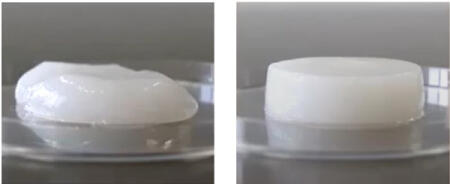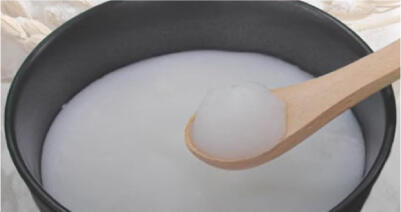(This is an English translation of the original Japanese article.
The publication date refers to that of the Japanese version,
which differs from the upload date of the English version.)
In September 2022, a rice flour for nursing care food called "Jelly Rice Flour" was released. This new type of rice flour was produced with the use of "a technology for preparing porridge jelly with appropriate physical properties from high-amylose rice flour by a simple method," which was developed and put into practical use by a research group led by the National Center for Global Health and Medicine. As the technology enables the easier use of jelly-like food derived from rice, it is expected to reduce the burden and labor of cooking and caregiving.
How the recipe for rice flour porridge jelly is made
According to the 2020 Vital Statistics Annual Report, the 6th leading cause of death in Japan is aspiration pneumonia, whose cases are increasing due to the rising elderly population. With this background, there is a growing need of considering the swallowing function of the elderly, in the preparation of nursing care food provided in hospitals, nursing care facilities and home care.
Rice is a useful staple food for the elderly, but in order to make ordinary rice easier to swallow, it requires a lot of effort by taking such steps as adding a starch-degrading enzyme to prevent the stickiness of cooked rice, making it into a paste with a mixer and then solidifying it with a gelling agent. In an effort to solve this problem, the National Agriculture and Food Research Organization discovered a cooking method that can easily produce "a rice flour porridge jelly," a low-stickiness, jelly-like food made from rice flour; this method is just boiling and cooling rice flour which has a high amylose content in starch mixed with water. Based on this basic method, a collaborative research for its practical use started with the participation of experts familiar with the actual situation, whose fields range widely from medicine, nursing care and welfare, and gerontology research, to community support, agricultural research, and the food industry. They worked on various issues such as whether the physical properties are appropriate, whether the taste is generally acceptable, and whehter there is a fail-safe cooking method.
There are many varieties of high-amylose rice, and the cooking characteristics of rice flour porridge jelly vary depending on the variety. Also, the milling method affects the physical properties and taste of the finished product. The research group tested various varieties of rice flour to make jelly, repeated physical property measurements and taste tests, and analyzed which conditions of rice flour and milling methods were suitable for making rice flour porridge jelly.
In addition, the research group conducted an evaluation test to see if rice flour porridge jelly could be safely eaten by patients with mild dysphagia, and evaluated whether the eaten jelly remained in the back of the throat or entered the trachea using a videoendoscopy. As a result, it was found that rice flour porridge jelly was less likely to remain in the throat than full porridge (cooked with equal amounts of rice and water) and could be eaten relatively safely. Trial production was carried out, and the samples were tasted by family members providing home care and hospital dietitians, which lead to the creation of recipes for easy cooking of rice flour porridge jelly with a home gas stove or microwave oven. A patent application has been filed for this research achievement (November 18, 2021).
In addition, when cooking rice flour porridge jelly using this recipe, the cooking time can be reduced to less than half compared to that for cooking rice and then make porridge. In nursing care, there is a shortage of manpower, and reducing the time for meal preparation is a major advantage. It is also easy to add flavor and therefore make its variations.

Photo 1 :Left Cooking rice flour from ordinary rice creates a sticky starchy paste that sticks to the throat.
Right Cooking rice flour from high-amylose rice produces a jelly that is less sticky and goes down smoothly.
(Provided by the National Center for Global Health and Medicine)
Rice flour for nursing care food starts sales in September 2022
The developed rice flour porridge jelly has been clinically confirmed to be useful and safe, and its sales as a nursing food called "Jelly Rice Flour" started in September 2022 (Photo 2). Jelly Rice Flour is sold in hospitals and nursing care facilities, and it can also be purchased on mail-order sites for around 1,600 yen/kg. Users have reported that they were able to easily make porridge jelly and that it was helpful since they can make it without using a mixer.

Photo 2 : Rice porridge jelly made with Jelly Rice Flour
(provided by the National Center for Global Health and Medicine)
Exporting rice flour for nursing care food in the future
Recently, aging of the population has become a social issue in Southeast Asian countries as well. Nursing care food made from rice, which is also a familiar staple food in Southeast Asia, is considered to be easily acceptable. In addition, rice flour is attracting attention overseas as a "gluten-free" food devoid of gluten, a type of protein found in wheat products.
This is inviting an expectation for the future export of rice flour for nursing care food. Junko Fujitani, director of rehabilitation department of the National Center for Global Health and Medicine, the representative institution of the research group, said: "The achievement of this research is very useful in clinical practice. Furthermore, the innovative aspect of this collaboration lies in the perspective that the characteristics inherent in rice varieties can be beneficial in medical and nursing care settings. I think that cooperation and information exchange will continue to be important."
A website summarizing the results of this research has been published:
https://komeko.ncgm.go.jp/
Glossary
High-amylose rice: A general term for rice cultivars that have a higher amylose content in starch (usually 25% or more) than ordinary rice
Project name
Research Program on Development of Innovative Technology(Development Research Stage)
Project period
FY2020 to 2022
Title
Development of Dysphagia Diet Using Rice Flour
Leading research institutes
National Center for Global Health and Medicine, Institute of Food Research of the National Agriculture and Food Research Organization (NFRI), Tokyo Metropolitan Institute for Geriatrics and Gerontology, University of Fukui Hospital, Komazawa Women's University, Ryokufuso Hospital, FoodCare Co., Ltd., Zushi Kokufun Co., Ltd.
This research project was applied to the Research Program on Development of Innovative Technology from the "Platform for Variety Development Promotion through Next Generation Breeding Technology" organized in the "Field for Knowledge Integration and Innovation," a mechanism for interdisciplinary fusion and industry-academic collaboration operated by the Ministry of Agriculture, Forestry and Fisheries.
URL for "Field for Knowledge Integration and Innovation"
https://www.knowledge.maff.go.jp/en/fkii.html
